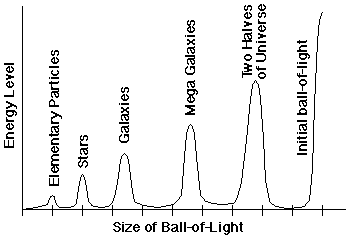 Summary of the Ball-of-Light Particle Model form of the Big Bang
Summary of the Ball-of-Light Particle Model form of the Big Bang

- There existed one ball-of-light containing all the energy of the universe.
- It split into two balls-of-light -- one half matter, the other half antimatter. (Possible smaller byproducts may have included: galactic size balls-of-light, stellar size balls-of-light, ordinary stable elementary particles, ordinary unstable elementary particles, and the photons that eventually became the "Background Radiation.")
- Each half exploded, creating "Mega-Galaxies". (Possible smaller byproducts may have included: galactic size balls-of-light, stellar size balls-of-light, ordinary stable elementary particles, ordinary unstable elementary particles and the photons that eventually became the "Background Radiation.")
- The Mega-Galaxies exploded, creating clusters of galaxies, galaxies, and the observed bubbly structure of the universe. (Possible smaller byproducts may have included: stellar size balls-of-light, ordinary stable elementary particles, ordinary unstable elementary particles and the photons that eventually became part of the "Background Radiation.")
- Galaxies exploded, creating stars. (Possible smaller byproducts may have included: ordinary stable elementary particles, ordinary unstable elementary particles and the photons.)
- Stars exploded, creating normal matter. (Possible smaller byproducts may have included: ordinary stable elementary particles, ordinary unstable elementary particles and the photons of light.)
- Nonharmonic ordinary matter decayed, creating ordinary stable elementary particles, ordinary unstable elementary particles and photons of light.
Induction of nonthermal radiation photons
On the surface of each of the elementary particles -- at each of these 7 levels -- are spinning patches electric and magnetic fields. In many cases the fields are not relatively strong and simply induce a photon. Collectively, these photons are called "nonthermal radiation."
In essence, "thermal radiation" is photons coming from the electrons that surround ordinary matter as they move from one electron orbit to another. Such photons have energy levels that predictable levels.
In essence, "nonthermal radiation" is photons coming from the cores of balls-of-light. While these photons are still multiples of Plank's Constant, they do not have predictable energy levels.
Induction of small balls-of-light
If the patches of electric and magnetic fields that are located on the surface of balls-of-light are strong enough, and are spinning around the surface of the ball-of-light with enough speed, then the electric and magnetic fields will be able to induce "small," normal elementary particles.
For example, the fields spinning around a neutron might induce:
- photons
- neutrinos
- electrons
- protons (hydrogen nuclei)
- helium nuclei
Induction of small to medium balls-of-light
Besides the particles listed above, the larger -- less harmonic -- fields around a star might induce larger particles, including:
- iron nuclei
- uranium nuclei
- balls-of-light that create sunspots
- balls-of-light that create planets
- balls-of-light that turn into baby stars
- if the original star is large enough, even the cores of normal stars
Induction of large balls-of-light
The massive fields around the core of galaxy would be strong enough to induce:
- normal stars
- abnormally large stars that explode into clusters of stars like the Tarantula Nebula in the Large Magellanic Cloud
- jets of material often seen coming out of the cores of galaxies
- mini galaxies that explode into globular clusters
- small ejected galaxies like those found around massive elliptical galaxies (See also, Cartwheel Galaxy)
Induction of massive balls-of-light
The fields around the core of a Mega-galaxy would have been strong enough to induce quasars.
